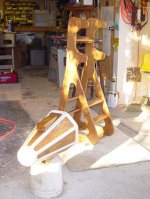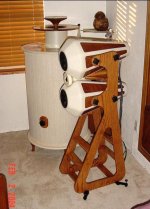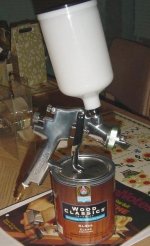A few years ago I embarked on an all out DIY main monitor project that used Scan-Speak Revelator Mid’s and the Vifa XT Tweeter, these took over 6 months to build and several hindered hours of hard labor, and once completed I chose a polyurethane clear coat to protect the “Bleached Stone” textured paint and Oak inlays. I was somewhat aware of the ambering effect that shellac and some other old school clear protective coatings caused but I had not seen the effects first hand until now. This may not be a big deal if these were all oak but the painted portions began to show the ambering within a few weeks and as time went on, they continued to get worse until it looked plane UGLY Yellow. Some areas were more yellow that others to such a degree that the whole project was ruined astatically speaking. My problem with this product is that there is absolutely no indication in the directions or any text that I can find that this will amber over time, and since Polyurethane is a fairly new product to woodworking I truly believed that is would not effect the surface like a shellac. Since the effect is not visible at first and goes on just like a clear lacquer, I had no idea what I was in for. While stripping off nearly $100 worth of textured paint (which took 2-weeks) I noticed that even the oak inlays had dulled in appearance, and began to get back there original luster once the poly coat was sanded off, which leads me to my question, Why ever use a Polyurethane clear coat since you can’t possible know what it will look like after some ageing, most paint looks good if it goes on good, but this stuff is a potential disaster after a few months. Why don’t manufacturers warn of ambering, the directions go into great detail of many obscure things that could rarely make a difference but leave out the most important thing, what it will look like later on! I love most of Minwax products, but IMO there is no use for Polyurethane whatsoever, and I have learned a very expensive and labor intensive lesson, never use Polyurethane again!
Now that I’m finished the speakers look as good as they did when I first built them in 2001, and my newly completed subs that have the same finish finally match the mains. So be warned, don’t take the final step of finishing lightly, ask professionals or use a well known product that will keep it’s luster over time. From now on I will be using a water based latex or lacquer clear coat.
Now that I’m finished the speakers look as good as they did when I first built them in 2001, and my newly completed subs that have the same finish finally match the mains. So be warned, don’t take the final step of finishing lightly, ask professionals or use a well known product that will keep it’s luster over time. From now on I will be using a water based latex or lacquer clear coat.
Attachments
😱
Hats off for an excellent looking loudspeaker.
Might I ask what design you've got sitting in your corner? The top section looks a lot like the new B&O speakers, but I'm a bit curious about the bottom, given its huge size.
Hats off for an excellent looking loudspeaker.
Might I ask what design you've got sitting in your corner? The top section looks a lot like the new B&O speakers, but I'm a bit curious about the bottom, given its huge size.
Angel:
I posted on this project a few months ago, but this forum moves fast so it's several pages down. Here is the link
http://www.diyaudio.com/forums/showthread.php?s=&threadid=25075&highlight=
I posted on this project a few months ago, but this forum moves fast so it's several pages down. Here is the link
http://www.diyaudio.com/forums/showthread.php?s=&threadid=25075&highlight=
Disabled Account
Joined 2003
This time I went to Sherwin Williams and asked what to use, the manager recommended "Waterborne Polyurethane Varnish" clear Gloss, part of there Wood Classics Interior line, he said it would not amber at all, hope he is right. I used a HVLP spray gun to apply it and it turned out much better then a rattle can would.
Attachments
I don't remember if this info is on the can's label, but from MINWAX's site: http://www.minwax.com/products/protective/fast-poly-direct.cfm
"Slight ambering may be experienced when Polyurethane is applied over light-colored wood surfaces. Always spot test in an inconspicuous area to ensure satisfactory results. For light-colored wood surfaces, we recommend protecting with Minwax® Polycrylic® Protective Finish."
"Slight ambering may be experienced when Polyurethane is applied over light-colored wood surfaces. Always spot test in an inconspicuous area to ensure satisfactory results. For light-colored wood surfaces, we recommend protecting with Minwax® Polycrylic® Protective Finish."
- Status
- Not open for further replies.
- Home
- Loudspeakers
- Multi-Way
- Polyurethane ruined my speakers finish...



